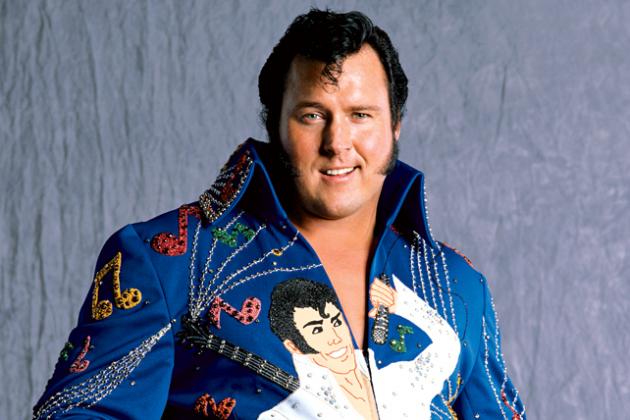He’s got long sideburns and his hair slicked back.
And he may or may not have arrived in our town with his pink Cadillac.
He’s the Honky Tonk Man.
If you watched the World Wrestling Federation (now World Wrestling Entertainment) in the late 80s and early 90s, you are sure to recognize him.
Honky, as he is known, has enjoyed a lengthy and well-respected career in wrestling, whether it was for the WWF or small promotions across the country.
He began his career in 1977 and worked in numerous territories as he began to make a name for himself in the wrestling business.
His early career included stints in the American Wrestling Association, Jim Crockett Promotions, Southeastern Championship Wrestling, and the famous Stampede Wrestling in Calgary, Alberta under Stu Hart.
Hart was the patriarch of the world-renowned Hart wrestling family which includes WWE Hall-of-Famer Bret “The Hitman” Hart, Davey Boy Smith, Owen Hart, and Jim “The Anvil” Neidhart.
“It was a pleasure and a chore,” Honky said of working at Stampede Wrestling. “Every day was exciting with all of the Hart children. They had enough for a whole team there just with the kids. I was there most times in the winter and as cold as it gets in Johnstown, it’s nothing like what it gets in Calgary.”
The Honky Tonk Man character was cultivated long before he made his debut in Vince McMahon’s WWF.
“I kicked it off in Southeastern Wrestling in the Pensacola, Mobile, and Birmingham areas,” Honky said. “I took it to Calgary and by the time WWE picked me up, I had perfected the character pretty well.”
The Honky Tonk Man character is arrogant, ego-centric, and the perfect bad guy, or heel in the wrestling lexicon.
He was hated across Canada and the United States, getting booed out of buildings nightly. He then caught the attention of the WWF thanks to Hulk Hogan, perhaps the most well-known professional wrestler in history.
“Hogan pitched me to Vince,” Honky commented. “WWF came up to Calgary for the annual Calgary Stampede. Stu Hart got me on the card that night and I saw Hogan. He wanted to me to come and work something out with them. Three days later I was in New York and months later I was on the road with them.”
Although McMahon initially saw the Honky Tonk Man character as a kid-friendly good guy or babyface, Honky said that eventually Vince changed his mind and went with him as a villain.
“I became a really good bad guy,” he said.
After a memorable rivalry with WWE Hall-of-Famer Jake “The Snake” Roberts, he entered another classic rivalry with Ricky “The Dragon” Steamboat.
They feuded over the prestigious Intercontinental Championship, which has been held by all-time greats throughout the years.
On June 13, 1987, McMahon decided to put the IC Title on Honky, marking his first championship in the WWF.
“I knew I could make this character work for the company,” Honky said. “Being able to capture the Intercontinental Championship catapulted me to main events all over the world. I told Vince if this doesn’t work I’d leave and go home, but it worked out well.”
To preserve his title, which could only be taken by pinfall or submission, Honky often got himself deliberately counted out or disqualified against challengers such as Steamboat, Billy Jack Haynes, Bruno Sammartino, and George “The Animal” Steele.
Honky began one of his most-memorable rivalries with the late “Macho Man” Randy Savage in September 1987, and it lasted well into 1988.
“We had run across each other earlier in our careers,” Honky said. “Randy was a real pro. We had that chemistry that worked in the ring. It was strictly business with him and it worked out well.”
Overall, Honky held the IC title for a record 454 days, culminating in matches with the upstart Ultimate Warrior.
“Now those matches were a chore,” he said. “Everything you’ve heard about Warrior is probably true. I dreaded getting up in the morning, it was very trying. But as time went on, I started incorporating things into the matches that he could do. That’s the most important thing, working with wrestlers and working with what they do well.”
After dropping the belt to Warrior, Honky made his exit from the WWF in 1991.
“Working with Vince was difficult at times because he is so demanding,” Honky said with a laugh. “When you work for him, you work. Vince didn’t like time off for any reason. It was a grind of 330 days a year, but the end result was he paid very well. That’s what we do this for.”
“I’ve been very fortunate. I haven’t had serious injuries and was able to reach the top of the mountain. I tell people that the reason I got into wrestling was because I never wanted to grow up. So, I’ve been pretty lucky in my career.”
He also wrestled for World Championship Wrestling but according to him that lasted three months tops.
“They were not big fans of mine,” Honky said. “I only wrestled a handful of matches before I decided it was time to go.”
Nowadays, Honky travels the independent circuit taking bookings from time to time.
“It takes me back to my creative control days,” Honky said. “It’s very fan friendly. I’ve been doing this for a long time and I enjoy doing it. I’m in charge of where I want to go, and I control my destiny.”
